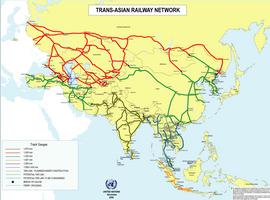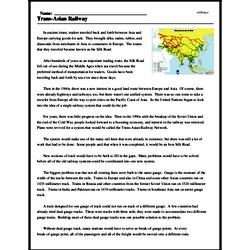Trans-Asian Railway
In ancient times, traders traveled back and forth between Asia and Europe carrying goods for sale. They brought silks, satins, rubies, and diamonds from merchants in Asia to consumers in Europe. The routes that they traveled became known as the Silk Road.
After hundreds of years as an important trading route, the Silk Road fell out of use during the Middle Ages when sea travel became the preferred method of transportation for traders. Goods have been traveling back and forth by sea ever since those days.
Then in the 1960s, there was a new interest in a good land route between Europe and Asia. Of course, there were already highways and railways, too, but there wasn't one unified system. There was no one route to take a traveler from Europe all the way to port cities on the Pacific Coast of Asia. So the United Nations began to look into the idea of a single railway system that could do the job.
For years, there was little progress on the idea. Then in the 1990s with the breakup of the Soviet Union and the end of the Cold War, people looked forward to a booming economy, and interest in the railway was renewed. Plans were revived for a system that would be called the Trans-Asian Railway Network.
The system would make use of the many rail lines that were already in existence, but there was still a lot of work that had to be done. Some people said that when it was completed, it would be an Iron Silk Road.




